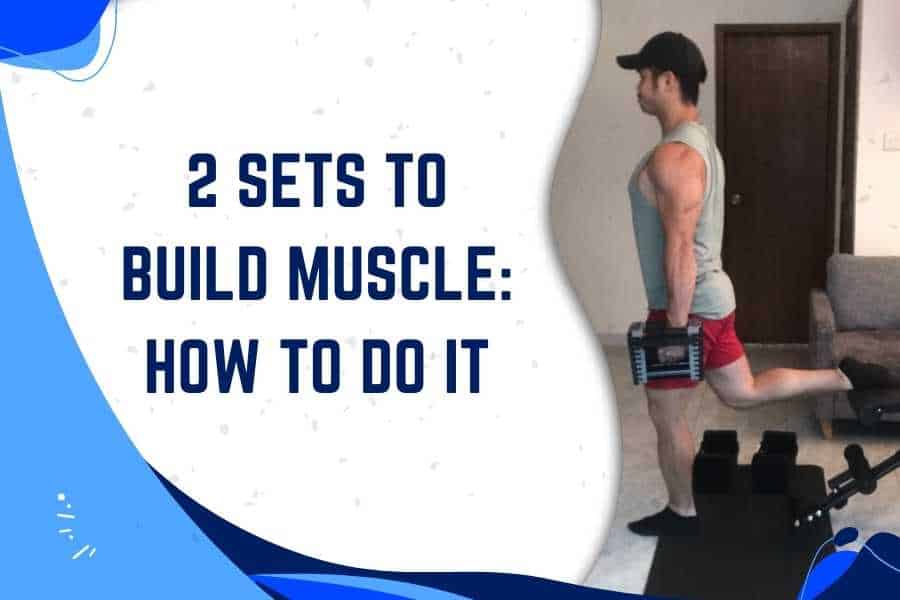If you’re stuck for time, you may have considered training with low sets at some point. This post explains why and how it is possible to build muscle by doing just 2 sets per muscle group per workout.
2 sets can be sufficient to promote hypertrophy if each set is taken to near failure. Doing this helps to ensure a sufficient training volume is reached. With that being said, it is not as effective for muscle growth as training with 3, 4, and 5 sets.
I also share 2 workout plans, both of which revolve around doing 2 sets per muscle, that I’ve personally tried and vouch for.
One is created by a bodybuilder whilst the other is by a powerlifter.
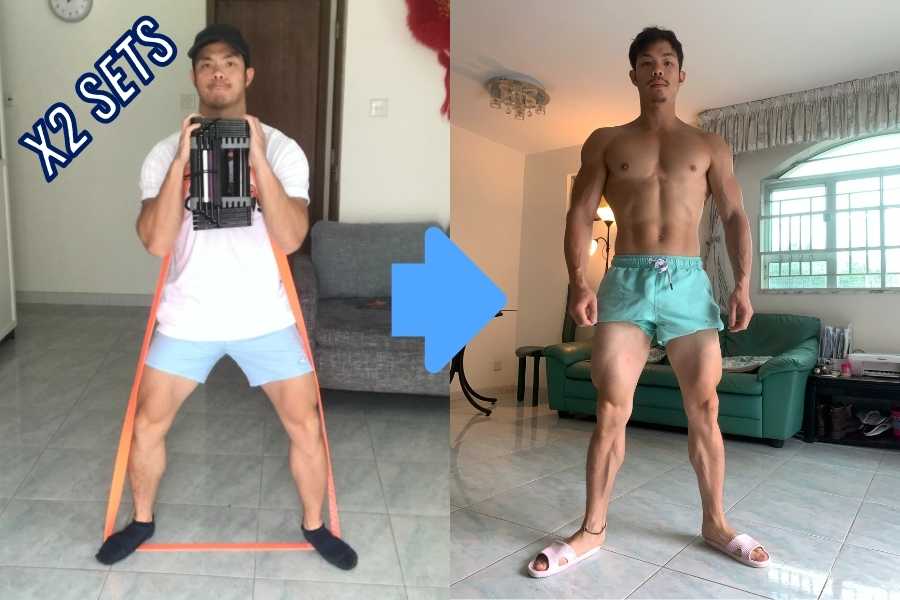
- Key Points
- Definition Of 2-Set Training
- Why 2 Sets Can Be Enough To Build Muscle
- Ideal Rep Range For 2 Sets To Build Muscle
- Example Workouts That Use 2 Sets To Build Muscle
- Bodybuilder's 2-Set Workout To Build Muscle
- Powerlifter's 2-Set Workout To Build Muscle
- Importance Of Training To Failure
- Are 2 Sets Enough To Gain Strength?
- Is It Better To Do 1, 2, 3, Or 4 Sets?
- Conclusion
Key Points
- 2 sets can build muscle if reps, weight, or training frequency are adjusted accordingly. But it’s generally not ideal for building strength.
- It’s best to use higher rep ranges of 10-15 (or more) per set to build muscle with 2 sets.
- Taking each set to failure is essential for the greatest hypertrophy benefits.
- Try the two workouts listed in this post!
- Progressive overload to ensure muscle growth.
Definition Of 2-Set Training
Performing 2 sets involve completing a specified number of consecutive repetitions, twice, with a break in between. For example, 2 sets of bicep curls could involve repeating the exercise for 8 repetitions, taking a 1-minute break, and repeating this for another set.
The number of reps, chosen rest period, and the weight used will vary largely depending on the exercise and your training goals. For example:
| Exercise | Sets | Reps | Rest Between Sets | Weight |
|---|---|---|---|---|
| Bench Press | 2 | 8 | 2 mins | 80% of 1RM |
| Squat | 2 | 9 | 3 mins | 75% of 1RM |
| Bicep Curl | 2 | 14 | 2 mins | 55% of 1RM |
| Chest Fly | 2 | 15 | 4 mins | 50% of 1RM |
Note: 1RM stands for 1 repetition maximum.
Whilst each exercise shares one thing in common- they’re all completed in 2 sets- the reps, rest, and weight are all different.
Why 2 Sets Can Be Enough To Build Muscle
Training for hypertrophy (muscle growth) and strength is not complicated. It simply boils down to reaching a sufficient weekly training volume.
So what is training volume?
It refers to the number of sets, reps, weights, and training days completed each week. In other words, it’s a measure of how much work you give your muscles.
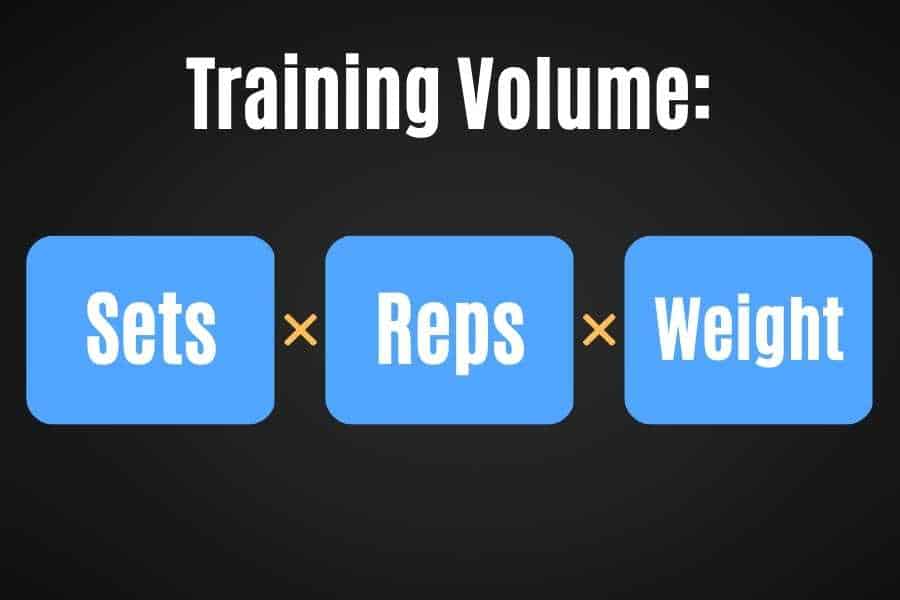
Looking at the above training volume formula, you can understand why 2 sets can be enough to build muscle.
Lifting weights in a low set range (for example, 2 sets per exercise per workout) can achieve a similar training volume as lifting weights in a higher set range (for example, 3 or 4 sets per exercise per workout).
How?
What you lack in the number of sets completed, you can make up for by lifting in a higher rep range, adding more weight, or increasing training days.
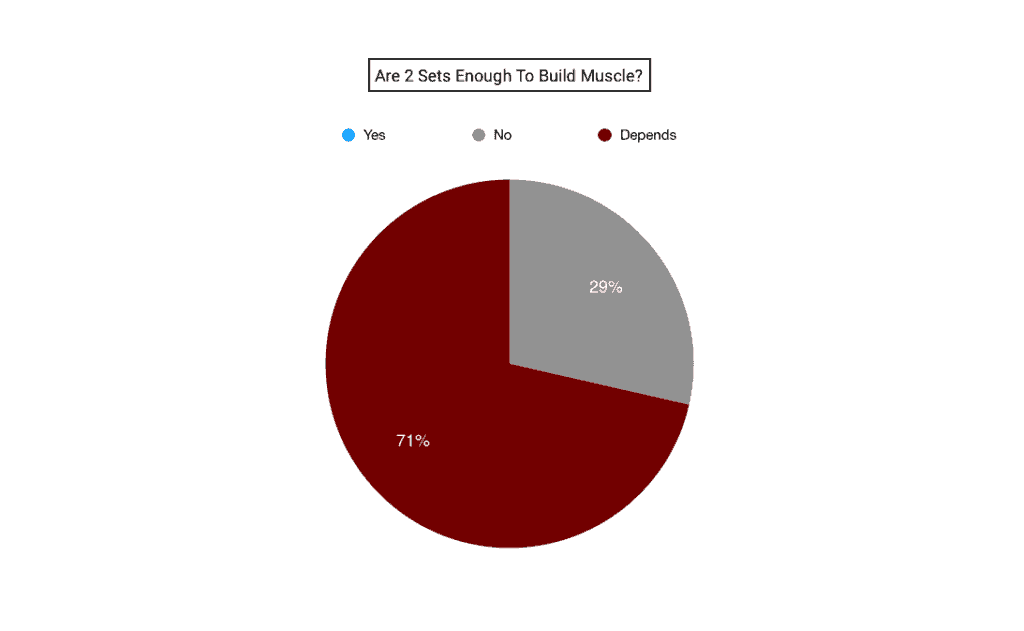
In support of this, 70% of respondents in this Reddit thread and this Quora thread agree that doing 2 sets per exercise per workout is sufficient to build muscle if you can adjust the intensity accordingly.
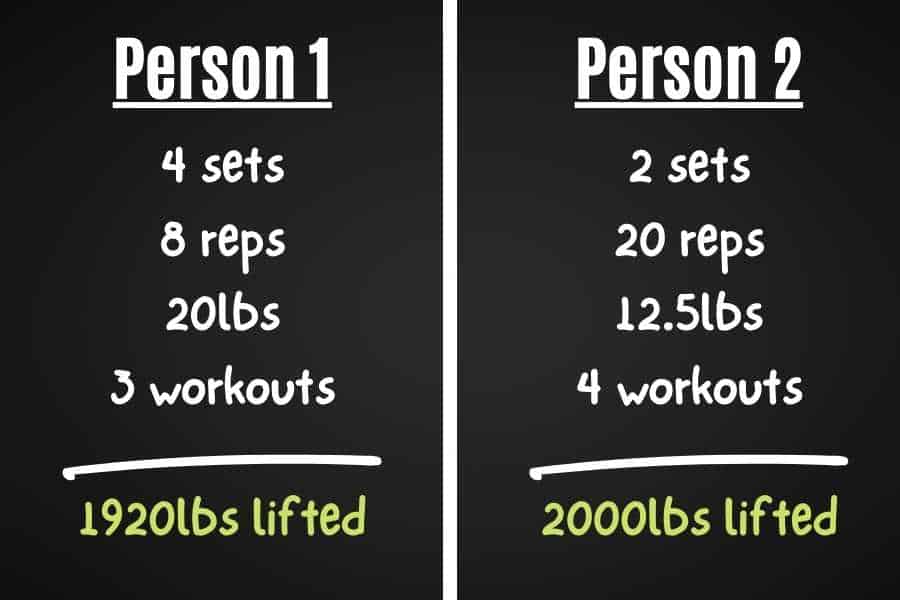
Take a look at these two hypothetical examples for a better idea:
- Person 1- bicep curls 4 sets of 8 reps at 20lbs for 3 times per week.
- Person 2- bicep curls 2 sets of 20 reps at 12.5lbs for 4 times per week.
A total of ~1900-2000lbs is lifted per week in both examples despite person 2 doing 2 sets less than person 1.
Thus, both people have completed a similar weekly training volume and should therefore see a similar degree of hypertrophy.
Take-home message:
It’s possible to build muscle by lifting 2 sets. But it’s essential to adjust your reps, weight, or training frequency accordingly to reach a sufficient training volume for hypertrophy.
If you’re a skinny newbie, you may also be interested in my 19 essential tips to get buff.
Ideal Rep Range For 2 Sets To Build Muscle
High rep ranges of 10 to 15 reps or more are ideal for building muscle using 2 sets. However, it’s important to choose a weight that challenges the target muscle to near-failure in order to gain the greatest hypertrophy benefits.
Now you may be thinking why 10-15 reps and not an even higher rep range, say 20-30?
The goal is to find a balance between lifting in a high rep range to increase training volume, but not so high that you can’t lift a moderately heavy weight.
After all, one of the main stimuli for hypertrophy is mechanical tension (which is achieved by lifting heavy weights).
Example Workouts That Use 2 Sets To Build Muscle
Below, are 2 example workouts that use 2 sets to promote hypertrophy.
The first workout is by a bodybuilder (Marc Lobliner). The second workout is by a powerlifter (Steve Shaw).
Bodybuilder’s 2-Set Workout To Build Muscle
Marc calls this the high reps to hugeness workout.
It involves performing each exercise with 2 sets of 15 reps, as follows:
- Do a generic warm-up and light warm-up sets to prepare your muscles.
- Rest for 1 to 2 minutes.
- Choose a weight that challenges you for 12 to 15 reps for the chosen exercise.
- Complete set 1 by performing 15 reps.
- Rest for another 1 to 2 minutes.
- Complete set 2 by performing another 15 reps.
- Repeat for all exercises in your workout.
This is the basic premise behind Marc’s 2 set workout. You’re essentially lifting in a high rep range to make up for the fact that you’re only completing 2 sets.
What An Example Workout Looks Like:
Here’s an example of a 5-day dumbbell training split following Marc’s high reps to hugeness workout principle:
- Monday- rest
- Tuesday- rest
- Wednesday- back and chest
- Thursday- legs and shoulders.
- Friday-back and chest
- Saturday- legs and shoulders
- Sunday- arms and abs.
| Back And Chest Day | Legs And Shoulders Day | Arms And Abs Day |
|---|---|---|
| Incline Row or Shrugs | Front Squat or Box Squat | Dumbbell Curl or Hammer Curl |
| Pull-Over or Reverse Fly | Deadlift or Romanian Deadlift | Tricep Kickback or Extension |
| Pull-up (Weighted) or One-Arm Row | Lunge or Calf-Raise | Weighted Dips or Reverse Curl |
| Bench Press or Narrow Bench Press | Shoulder Press or Lateral Raise | Weighted Crunch |
| Incline Bench Press or Chest Fly | Hammer Press or Front Raise | Side Bend |
| Dumbbell Cross-Over or Decline Bench Press | High Pull or Incline Reverse Fly | Leg Raise |
How To Do It:
For each workout, you’ll target two muscle groups with 3 exercises each (choose one from each block).
Each exercise is performed in 2 sets.
This equates to 12 total sets per muscle group per week, which is within the recommended 10-20 sets per muscle per week for hypertrophy.
The exception would be for arms and abs, where you only complete 6 direct sets per week through the other compound exercises which also hit these muscle groups).
How To Progress:
Remember to increase the weight when 15 reps become easy. This is called progressive overload, and it ensures your continue to get stronger and grow bigger rather than plateau.
A telltale sign you should increase weight is when you feel you have the capacity to squeeze out a couple more reps by the end of each set. In other words, when your 2 sets start to feel easy.
In contrast, you can use rest pauses if you find that 15 reps are too hard to lift.
A rest-pause involves prematurely ending your set, taking a 5-second break to recover with deep breaths, before resuming your 15 reps. You’re essentially splitting your 2 sets into multiple mini-sets as required.
Alternatively, you could just decrease weight by 5lbs.
The important point is to hit those 15 reps for 2 sets at all costs!
Powerlifter’s 2-Set Workout To Build Muscle
Steve Shaw calls this the double-down workout and it also involves performing 2 sets per exercise.
The first set requires you to do 10 reps, and the second set is for as many reps as possible (AMRAP), up to 15 reps.
Additionally, you’ll also do a “finisher set” after the two sets. This requires you to do 50 reps of any exercise for that muscle group, as quickly as possible (ideally to the point where you can’t possibly do another rep).
Here’s how to do Steves’s double-down workout:
- Work 2 muscle groups per workout and hit each muscle group twice per week.
- Perform 2 exercises per muscle group.
- The first set involves 10 reps using a weight that challenges you for the 10 reps.
- Rest for 1 to 2 minutes.
- The second set involves doing AMRAP up to 15 reps using the same weight as the first set (increase weight if you can do more than 15).
- Rest for 1 to 2 minutes.
- Complete a finisher set of 50 reps to failure.
- Rest for 3 to 4 minutes
- Repeat for another muscle group.
Just like in the previous example, this workout is predicated on increasing your rep range to make up for the fact that you’re only completing 2 sets per exercise (3 if you include the finisher sets).
What An Example Workout Looks Like:
Here’s an example of a 5-day dumbbell training split following Steve’s double-down workout principle:
Follow a 5-day training split:
- Monday- rest
- Tuesday- rest
- Wednesday- back and chest
- Thursday- legs and shoulders.
- Friday-back and chest
- Saturday- legs and shoulders
- Sunday- arms and abs
Here’s an example of back and chest day:
| Exercise | Sets | Reps |
|---|---|---|
| Bent-Over Row or Pull-Up (Weighted) | 2 | 10, 15 |
| Reverse Fly or Shrug | 2 | 10, 15 |
| Any Back Exercise Of Your Choice | 1 | 50 |
| Bench Press or Incline Bench Press | 2 | 10, 15 |
| Chest Fly or Dumbbell Cross Over | 2 | 10, 15 |
| Any Chest Exercise Of Your Choice | 1 | 50 |
Here’s an example of legs and shoulders day:
| Exercise | Sets | Reps |
|---|---|---|
| Front Squat or Dumbbell Squat | 2 | 10, 15 |
| Deadlift or Lunge | 2 | 10, 15 |
| Any Leg Exercise Of Your Choice | 1 | 50 |
| Shoulder Press or Hammer Press | 2 | 10, 15 |
| Lateral Raise or Front Raise | 2 | 10, 15 |
| Any Shoulder Exercise Of Your Choice | 1 | 50 |
Here’s an example of arms and abs day:
| Exercise | Sets | Reps |
|---|---|---|
| Bicep Curl Or Hammer Curl | 2 | 10, 15 |
| Tricep Kickback or Overhead Extension | 2 | 10, 15 |
| Any Arm Exercise Of Your Choice | 1 | 50 |
| Weighted Crunch | 2 | 10, 15 |
| Leg Raise or Side Bend | 2 | 10, 15 |
| Any Ab Exercise Of Your Choice | 1 | 50 |
How To Do It:
Each muscle group gets 4 working sets and a finisher set for each workout. And you’ll hit each muscle group twice per week (except arms and abs which is only once per week).
This equates to 10 sets per muscle group per week. This is sufficient for hypertrophy assuming you lift enough weight to challenge yourself in each set.
This is essential to maximize training volume and to make up for the fact you’re only doing 2 sets per exercise.
How To Progress:
Just like Marc Lobliner’s workout, you can also use rest-pauses if required, and increase weight as necessary to challenge your muscles.
Also, make sure you don’t sacrifice form for weight.
Importance Of Training To Failure
When doing 2 sets per exercise to build muscle, the primary concern is in not reaching a sufficient training volume to promote hypertrophy.
This can be compensated for by working in a high rep range using an adequate weight and reaching failure on each set.
This means you should complete each set until you can no longer physically do another rep. Indeed, that’s the main premise behind the above 2-set workout examples.
At the very minimum, you should reach close to failure if you want to maximize hypertrophy from doing just 2-sets.
In support of this, a 2016 study showed that high and low reps can promote similar muscle growth, as long as sets are pushed to failure.
Are 2 Sets Enough To Gain Strength?
2 sets are generally insufficient to get stronger. Strength training typically involves lifting heavy weights for low reps and high sets to increase muscular capacity to overcome resistance. This is nearly impossible to achieve when performing a limited number of sets.
Most strength-focused training programs require you to lift around 5-6 sets, and 3 sets at a minimum, of around 5 reps per exercise.
The problem with doing 2 sets for building strength mainly boils down to using an insufficient weight.
As you know, you need to be lifting in high rep ranges to make the most from doing a limited number of sets.
But this invariably means decreasing weight. And building strength is predicated on lifting as heavy as possible.
The alternative is to decrease your rep range down to the traditional strength-building rep zone (around 4-6 reps per set).
But this is simply an insufficient volume for optimal strength gains.
Overall, beginners may be able to build some strength by lifting 2 sets. But trained lifters are unlikely to get much stronger. Either way, 2 sets can be utilized for hypertrophy but it’s not optimal for getting stronger.
Is It Better To Do 1, 2, 3, Or 4 Sets?
Generally speaking, the more sets you do the better. In other words; doing 1 set is better than not training at all, 2 sets are better 1 set, 3 sets are better than 2 sets, and so on.
Why?
Your muscles show a dose-response to training. This means the greater the training volume the greater the benefits returned.
Of course, limits apply to this rule. There comes a point where the benefits stop and further sets become counterproductive.
The onset of overtraining begins after exceeding around 6 sets per muscle per workout. Here, there is a significant diminishment in training benefits returned, and doing extra sets may even impair muscle recovery.
Additionally, the goal you’re optimizing for affects your ideal number of sets, as follows:
| Goal | Ideal Number Of Sets Per Muscle Group Per Workout |
|---|---|
| Muscle Strength | 5-6 |
| Muscle Hypertrophy | 3-4 |
Performing 3 to 4 sets per muscle group per workout is generally the accepted standard for hypertrophy. It strikes a good balance between workload without overtraining a muscle.
But that doesn’t mean it’s the only way to go.
In fact, I’ve shared two workout programs that utilize 2-set exercises (both created by well-respected professionals).
But be aware that these workouts require you to work to muscular failure (or close to failure) for maximum effect. And if you’ve ever trained to failure, you’ll know it’s intense and not for the faint-hearted.
If you’re new to training, then you can check out my other article to learn how to tell your muscles are growing!
Conclusion
Whilst it’s not great for building strength, working with 2 sets can be enough to build muscle if each set is performed at a sufficient intensity.
In order to do this, it’s recommended to work in a high rep range (10-15) using a weight that challenges you to near-failure in each set.
Additionally, optimal hypertrophy requires you to apply progressive overload by increasing weight over time.
You may also be interested in the downloadable Kalibre Blueprint PDF which details exactly how I gained 40lbs of lean muscle (it’s 100% free!). It details the exact exercises and nutrition (with printables) I used to go from skinny to ripped!

